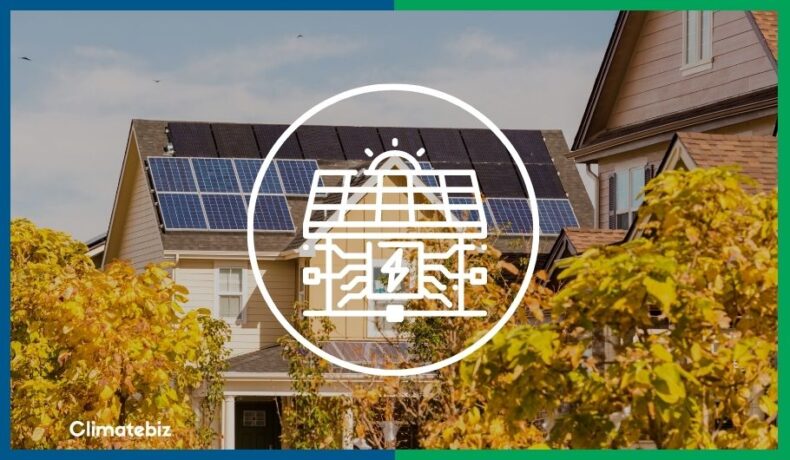Finally, after many years you’ve saved up enough for the mortgage deposit. Your new Tesla is in the driveway, and as the realtor hands over the keys to your new house, you grin with joy. The only missing piece is a solar array to power your 21st-century clean energy car! So, how many solar panels do you need for a 2500 sq ft home?
We’ll get straight into the nitty gritty for your home and how to go about sizing a solar system for your house.
Table of Contents
How Much Energy Do I Use?

The first step is to look at your monthly electricity bills. You should tally up the monthly energy usage (in kWh) over an entire year. The US average is about 11,000 kWh per year, but it varies by region. Your usage will be higher if you have air conditioning, electric space heating, or an electric vehicle.
Next, you should consider whether you plan to add anything to your house that will increase its energy usage.
Are you thinking about installing a sauna or jacuzzi? Have you considered changing an oil heater for an electric one? You should add the usage of these future appliances to your annual total if you are thinking about buying them.
When Do I Use Energy?
House size influences how much energy you use.
2500 square feet is the average size of a house in the USA, although older homes tend to be smaller. But it’s also essential to consider when you use electricity.
Simply put, your home’s daily energy consumption reflects what you do during the day!

First Scenario: You’re Home All The Time
Let’s first look at a scenario where you spend most of the day at home, cooking food, cleaning, washing clothes, and working using household appliances. Consequently, you’ll use more energy during daylight hours.
This might be because you have young children, a home office, or you are running a business or studying from home.
As such, you’ll be able to use lots of energy from your home solar array directly in your household. Your energy won’t be sold back to the grid for a pittance.
In this scenario, your solar array will provide around 50% of your annual energy supply. For a house using 11,000 kWh per year, this is 5,500 kWh.
Second Scenario: You’re Only Home Mornings and Evenings
The second scenario we’ll look at involves you working away from home during the day. This means that you tend to use more energy during the mornings, and evenings, with a background level of energy usage from idle appliances during the daytime, e.g., the fridge. You might have some appliances timed to switch on during the cheaper daylight hours of the day, but this won’t be happening all the time.
In this scenario, your solar array will provide around 30% of your annual energy supply. For a house using 11,000 kWh per year, this is 3,300 kWh.
Third Scenario: You Work Away But Also Have An Electric Car
The third scenario involves you working away from home and owning an electric car. In this scenario, you’ll need to recharge that car when you return home.
The average electric vehicle driver in the USA drives about 5,300 miles per year. The average electric car uses about 0.35 kWh per mile driven.
Of course, if you’re driving during daylight hours, you could also consider installing solar storage in your home to better use the energy produced by the solar array. Doing this will allow you to store any unused solar energy made by the array to charge your car when you return in the evenings; it all depends on whether you work days or nights.
Assuming that you charge your car at home 75% of the time, your home energy usage will increase by an amount equal to 75% of the total energy your EV uses.
Therefore, your increased usage would be:
0.75 x 5300 x 0.35 = 1391 kWh per year.
If you religiously charge your EV at home or drive more than the average distance in a year, you can adjust that calculation accordingly.
In the case of the average house, this will bring the annual total from the solar array to:
3,300 + 1,391 = 4,691 kWh.
What Solar System Size Do I Need For A 2500 sq ft Home?
To size a solar system for your home, you first need to calculate the energy your system can produce.
Assuming you stay home and use the solar energy produced, this would be about 5,500 kWh.
Next, you need to use the peak sun hours method to size the power rating of your array.
Annual Energy (in kWh) = PSH (hours) x Panel Peak Power (in kW) x 365
In the next section, we’ll look at some working examples for homes in different parts of the U.S.
Example 1: California

Peak Sun Hours (PSH) for California is 2.5 hours.
Applying the equation:
5500 (in kWh) = 5.2 (hours) x Panel Peak Power (in kW) x 365
So Peak Panel Output = 5500 / 5.2 / 365 = 2.90 kW
Therefore, your solar array would need to have a peak output of 2.9 kW.
Example 2: Alaska

Peak Sun Hours (PSH) for Alaska is 2.5 hours.
Applying the equation:
5500 (in kWh) = 2.5 (hours) x Panel Peak Power Output (in kW) x 365
So Peak Panel Output = 5500 / 2.5 / 365 = 6.0 kW
Therefore, your solar array would need to have a peak output of 6.0 kW.
How Many Solar Panels Do I Need For A 2500 sq ft Home?
Now that we’ve assessed the peak power output of your solar array, the next step is to work out which panels you should choose.
Which Panels Do I Choose?
Choosing the right panels for your home is partly personal, economic, and technical.
Firstly, you should have a specialist assess your roof to determine whether it can sustain the additional weight of solar panels. If weight is a concern, you might consider thin film solar panels, as they are lighter.
Second, you should consider which panels you like the look of. Solar panels are not just black or dark blue; there are dyed panels and panels made to integrate visually into various roofs. Look around; you might find a product that visually fits your roof best.
Finally, you should consider basic costs. The fundamental measure is the cost per Watt, which you can obtain by dividing the price of a panel by its power out in Watts. All things being equal (quality, warranty terms, and output), you should buy the cheapest panel on a cost per Watt basis.
Number Of Panels Required (Sizing)
The next step is to work out how many panels you need.
Very simply, you divide the total system power by the power per panel, as below:
Number of Solar Panels = Panel Peak Power (in kW) / Solar Panel Peak Power (in W)
Remember, size matters here. Whatever panel wattage you choose, be it 100, 200, 400, 500 (or any other size), you’ll need to adjust your system accordingly.
But for these examples, we assume you selected a 345 Watt solar panel.
Example 1: California
Remember, we calculated that we needed a 2.90 kW array in California.
Applying the equation:
Number of Solar Panels = Panel Peak Power (in kW) / Solar Panel Peak Power (in W)
So Peak Panel Output = 2.90 / 0.345 = 8.4
After rounding up, your solar array must have 9 panels to reach 2.90 kW peak output.
Example 2: Alaska
Remember, we calculated that we needed a 6.0 kW array in Alaska.
Applying the equation:
Number of Solar Panels = Panel Peak Power (in kW) / Solar Panel Peak Power (in W)
So Peak Panel Output = 6.0 / 0.345 = 17.4
After rounding up, your solar array must have 18 panels to reach 6.0 kW peak output.
Final Thoughts
Working out the number of solar panels for a 2500 sq ft home doesn’t have to be complicated. The steps above will go a long way in helping you figure out how many solar panels your home needs. You’ll feel more confident negotiating with solar contractors.
Feel free to leave a comment below! Alternatively, follow us on Twitter or join our community!

